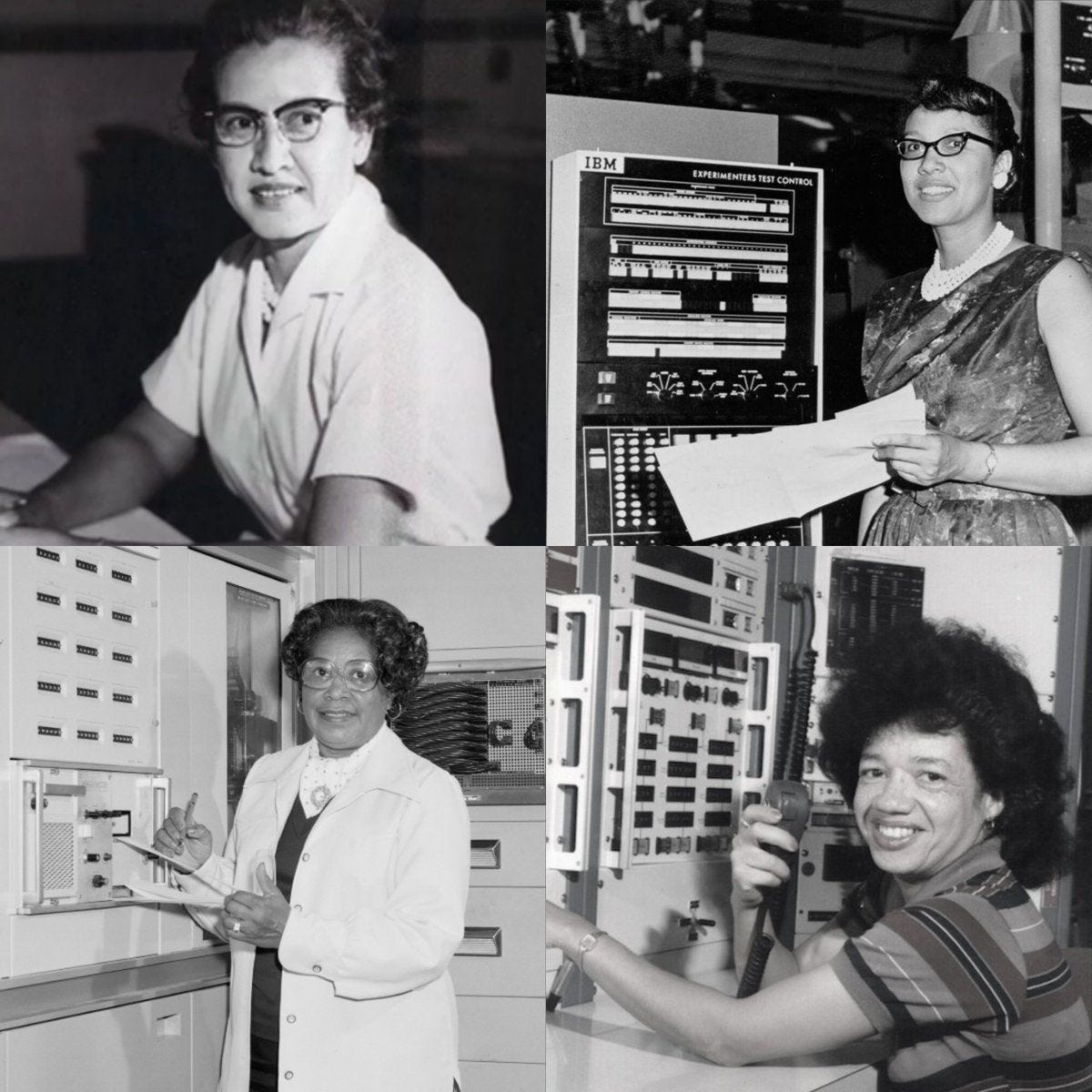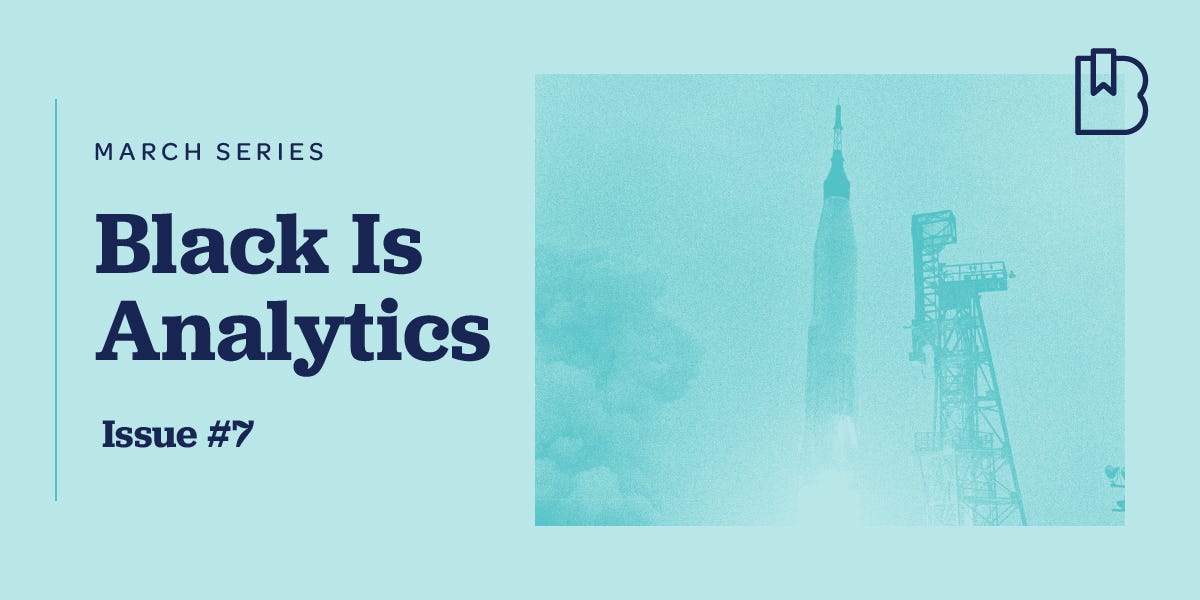Black Is Analytics
Welcome to issue #7! 🧮
For anyone who is new to Black To School, we explore the history and contributions of Africans and the African diaspora to global society. Our goal is to learn from these stories, draw inspiration, and make a positive change in our own lives, homes, and communities. If you received a forwarded issue, you can subscribe to Black To School here.
We’re so grateful to all of our readers for tuning in and sharing Black To School with others. This week, we’re starting a new tradition! We’re giving a big shout out 🎤 to readers who are also top sharers or “Golden Griots” of the previous week’s Black To School issue. Please keep sharing this information and #blackstories as a whole!
Kongnwehsusu A.
Andrene S.
Nik R.
Obinna O.
Here’s the thing about Black analytics, it has helped us go where no human nor machine has gone before. In this issue, we’ll:
Take an insider’s tour of a government unit, staffed entirely by Black, female mathematicians whose calculations led to some of the world’s greatest breakthroughs, including putting the first human on the moon.
Reflect on the ripple effects of those great minds and participate in awesome opportunities now available to promote and invest in next generation innovators.

Powered by Human Computers
Contributor: Dhyia Thompson-Phillips
The mental math of geniuses like Benjamin Banneker, Thomas Fuller and many others (Issue #6) highlighted our unrealized potential to contribute at every level of society. It wasn’t until June 1941 when President Roosevelt, under-pressure, issued an Executive Order banning discrimination in the Defense Industry that the doors started to open for some of the brightest minds of all time.
Since then, four generations of Black mathematicians, engineers, and scientists have contributed to countless discoveries and inventions across the globe.
How were women in the field of mathematics able to share their gifts more broadly?
In less than half a century, women with math degrees went from being confined to careers in education to jobs in programming and computing. Previously, women educated in mathematics were predominantly teachers. However, in the mid-twentieth century, given their analytical skills, there were five macro trends that led to new employment opportunities for them:
Rise of data collection and increasing demand for analysis to support advancements in the fields of astronomy, engineering, aerospace, and defense.
Loss of manpower as more men enlisted to fight in World War II.
Shift in perceptions of data analysis as tedious work, requiring long hours, repetitive tasks, and strict precision.
Cheaper labor cost of women (~50%) relative to men in the same roles.
Elimination of legal restrictions on employing married women.
Before the war, there were 5 women computers working at Langley Research Center. By 1946, there were 400 female human computers who had joined their ranks. Studying the factors that drive human progress is just as important as celebrating the results. The better we understand what levers lead to positive change, the greater the opportunity to accelerate and replicate these outcomes in other areas of society. The National Aeronautics and Space Administration (NASA) (predecessor known as NACA until 1958) offers one of the best examples of the transformational impact of Black women in the workforce.
Did you know Black, female mathematicians helped put a man on the moon?
White women mathematicians were first hired as human calculators by California’s Jet Propulsion Laboratory (JPL) in 1939. When the U.S. joined the war, it raised the stakes and the need for computing power. NASA enlisted the women of JPL to assist male engineers and scientists with coding, computer programming, and other technical analysis. The first Black female in a technical role at JPL, Janez Lawson, was educated as a chemical engineer. She was one of the first people to be trained to operate NASA’s new IBM computers. She was one in a long line of African American math workers who broke the color line.
On NASA’s West campus in Virginia, formerly a slave plantation, the women who worked there were called West Area Computers. They were black women with math and other technical degrees who were hired to assist with data tracking, analysis, and experimentation. As a result of Virginia’s Jim Crow laws, to be hired, Black female computers were required, as an additional hurdle, to take a chemistry course at a nearby college. Once hired, they worked in the West Area of Langley, which was 1 mile from the main, East campus with segregated dining, boarding, and restrooms.
At its peak, Langley employed as many as 50 Black computers. They compiled and processed data recorded from tests; conducted hundreds of calculations; and created charts and graphs to include in reports. Some of the more complex problems they tackled required everything from analytical geometry to linear algebra to estimate the lift, position, and trajectory of satellites and eventually manned spaceships.
Unlike distinguished astronauts like John Glenn (the first American to orbit Earth) and Neil Armstrong (the first person to walk on the moon), the names and contributions of Annie Easley, Christine Darden, Dorothy Vaughn, Katherine Johnson, Mary Jackson, Miriam Mann and dozens of other Black, female mathematical geniuses responsible for these achievements remained largely unknown for more than 50 years.

Hidden Figures No More…Ripple Effect
After receiving the Presidential Medal of Freedom in 2015 by President Barack Obama, the story of Katherine Johnson and the women of West Area Computers went viral (watch this 3 minute video). In 2016, a New York Times best seller was written by Margot Lee Shetterly about their work called Hidden Figures, which was later adapted into a movie that grossed well over $200M worldwide (9x its budget). The story of the West Area Computers is but one of many that paint a powerful picture of 20th century Black analytics.
Their calculations not only helped us achieve success in the arms and space race, but also laid the groundwork for renewable energy technology and much more. Their tremendous accomplishments have not only captured the hearts and minds of the world; but also, inspired a generation of Black mathematicians, engineers, inventors, scientists, astronauts, academics, and, yes, NASA leaders. Black analytics power the operations and innovation of institutions around the world.
🛠️ The Black To School Toolkit
Now What? Dig Deeper with Friends, Family, and Others.
Interested in learning more about Black human computers? Check out this 30 min interview with Hidden Figures author, Margot Shetterly Lee, that tells the story of the women of West Area Computers. Is your interest piqued? Watch this featurette of the Hidden Figures movie, which broke Box Office records. And buy the book!
Want to learn about our amazing history in the field of mathematics? See the faces and read profiles of brilliant Black mathematicians throughout history and all over the world.
Share these trailblazing stories of Black female mathematicians with your kids? Here is a short educational video about the work of Dorothy Vaughn and a book about Katherine Johnson. For story time at home, get the book Hidden Figures for children.
Ready to connect with today’s top talent? Celebrate these modern-day, Black math scholars. Also, join or support the National Society of Black Engineers (NSBE), an organization with over 22,000 members, focused on the growth and success of Black math, science, and engineering students & professionals.
Exploring a career change? There are 429,000 open computing jobs nationwide. The demand for computer programming (i.e., coding) is by far the highest. Click here and join Reskill Americans as they answer “the call” by providing free coding classes to thousands of African Americans.
Curious about opportunities to invest in Black female innovators? Goldman Sachs just launched a $10 Billion fund to invest in one million Black, female entrepreneurs over the next 10 years. Interested in getting in on the action? Invest in BackStage Capital’s $5 Million campaign to back underestimated founders (minimum investment $100).
⌛ The Black To School Timeline
Black Analytics Power the Operations and Innovation of Institutions Around the World.
We began by getting a glimpse of the Stone Age (Over 43,000 Years Ago) The Thing: Lebombo bone, the first calculator in the world, created by African women, which laid the groundwork for advanced math used around the world.
Last week, we stepped into the 17th & 18th Century (About 300 to 400 Years Ago) The People: Enslaved mathematicians, including Thomas Fuller and Benjamin Banneker whose genius and contributions defied and threatened the institution of slavery.
This week, we’ll visit NASA in the 1950s (70 Years Ago) The Place: West Area Computers, the Black female mathematicians whose calculations put a man on the moon.
Next week, we’ll experience what is new and true in STE(A)M today (Here and Now) The Practices: These experiments and promising approaches have students, parents, educators, artists, and futurists excited about reinventing the way we learn and experience math.
About This Week’s Contributor
Dhyia Thompson-Phillips
I serve as the Executive Director of a workforce program at Olive-Harvey College, a small community college, on the far Southeast side of Chicago. My husband, pup Fruity, and I live in Chicago and enjoy spending our time along the lakefront. I am a space exploration enthusiast and major advocate of increasing Black representation in computer science, robotics, and machine learning.
In high school, I was obsessed with NASA, the Apollo missions, and the space program. I even attended NASA Space Academy my senior year, earning college credit in Physics. I earned a Bachelor of Arts in Political Science from the University of Illinois @Champaign-Urbana with a minor in Computer Science and a double master’s degree in Education.
I am especially delighted to contribute to this Issue because of a dear friendship that I formed with Janet (Darden) Gipson, the daughter of Christine Darden. Christine is one of the Hidden Figures and the first Black woman to be promoted into the Senior Executive Service at NASA (which is the highest rank for civil service). Janet, like her mom, has also soared to new heights as the Vice President of Talent Acquisitions at Global Medical Response. Gipson and her husband are raising two talented young men who are college-bound. They, too, will reap the benefits of the Darden legacy and follow the path of Black excellence.
It is quite surreal to think that Janet’s mom and others like her performed calculations that powered the Apollo missions. How will our collective story change now that young Black boys and girls around the world are learning that there is representation and a legacy of talent at NASA and beyond that looks like them?
About Black To School
Black To School is a collaborative volunteer effort focused on sharing Black history, collecting helpful resources, and creating a safe space for discussion. Learn more about us here and feel free to join our Slack community to keep the conversation going. People of all backgrounds are welcome!
If you’re passionate about this type of work and want to help out, please let us know! The best way to get in touch is by emailing info@blcktoschool.com with “volunteer” as the subject, or by joining our Slack community and sharing that you’d like to be involved.





